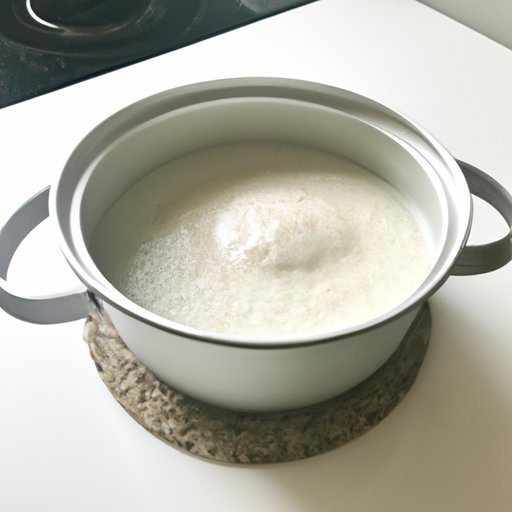
Introduction
There’s nothing more disappointing than ladling yourself a bowl of soup, only to find it’s thin and watery. Luckily, there are many ways to thicken up your soup to achieve the perfect consistency. In this article, we’ll explore five main ways to thicken your soup, as well as ingredient swaps, flour-free thickening options, troubleshooting tips and hacks for busy weeknights.
5 Ways to Achieve a Perfectly Thick Soup Every Time
The first method we’ll explore is the concept of a roux, a mixture of equal parts flour and fat that’s cooked together before being added to a soup. This is a classic technique for thickening soups and sauces.
To make a roux, simply melt your fat (butter or oil) in a saucepan over medium heat, add your flour and stir for 2-3 minutes until it turns golden brown. Be careful not to burn the roux, or it will give the soup an unpleasant taste.
Next, gradually stir in some of the hot soup broth using a whisk until a smooth consistency is achieved. Then, stir the mixture back into the pot of soup and bring to a boil, continuing to stir occasionally for the next 10-15 minutes until thickened.
Another popular option for thickening soup is to make a cornstarch slurry. To do this, mix together equal parts cornstarch and cold water or broth, whisking until smooth. Add the slurry to the soup, stirring constantly, and cook for 5-10 minutes until the soup is thickened to your liking.
Pureeing some of the soup’s vegetables is another technique that can add thickness as well as flavor. Simply remove some of the cooked vegetables from the soup and blend them until smooth. Stir the puree back into the soup and simmer until thickened. Keep in mind that this method will work best for soups with chunky vegetables, like vegetable soup or minestrone.
Other thickening techniques include using crackers or bread crumbs mixed with a bit of broth and added to the soup, or mashing up a few potatoes and adding them to the soup to thicken it up.
Ingredient Swaps for Thick and Creamy Soups
Thick soups and creamy soups are not the same thing, but both can be achieved by swapping in ingredients that will add body and texture to the soup.
To thicken a soup and make it creamy, try using ingredients like coconut milk or heavy cream. These will add richness without changing the overall flavor of the soup too much. Mashed potatoes can also be used to thicken a soup and give it a creamier texture, particularly for creamy vegetable soups.
However, be cautious not to overuse these ingredients, as they can also make the soup too heavy and dull the flavor. Use them in moderation, and taste as you go to ensure the soup still has enough of its original flavor.
Thickening Soup Without Flour
Some people may prefer to avoid flour in their soups, either for dietary or personal reasons. There are still plenty of options available for thickening up your soup without this common thickener.
One substitute is arrowroot powder, which is a gluten-free thickening agent that can be used in place of flour. It works similarly to cornstarch, but does not break down as easily when exposed to heat for extended periods. Be careful not to overuse it, as it can create a slimy texture if too much is added.
Another alternative for a creamier soup is to use silken tofu, which can be blended with the soup to create a smooth texture. This option works best for creamy vegetable soups like tomato or mushroom soup.
When using these ingredients, take care to add them towards the end of the cooking process, as they don’t require as much cooking time as flour-based thickeners.
How to Save a Watery Soup
Even the best-made soups can sometimes turn out too thin. The good news is that there are still ways to save a soup that’s too watery.
One option is to simmer the soup for a longer period of time, allowing the water to evaporate and the flavors to meld together. This method works best for soups that don’t have any delicate ingredients that may overcook, like leafy greens or seafood.
Another option is to stir in an absorbent ingredient like mashed potatoes or cooked rice. These will soak up the excess liquid and add some extra flavor as well. This method is particularly useful for soups that have already been overcooked or left to sit for too long, which can often cause them to become watery.
Soup Thickening Hacks for Busy Weeknights
Sometimes, you need a quick and easy solution for thickening your soup on a busy weeknight. Fortunately, there are a few shortcuts you can take to achieve that perfect consistency in no time.
Instant mashed potatoes can be a lifesaver when you’re in a hurry. Simply sprinkle some into the soup and stir until it reaches the desired consistency. This works best for creamy or thicker soups like potato soup or corn chowder.
Alternatively, whisking in a pat of butter can add some richness and body to a soup. Be careful not to add too much, however, as it can also make the soup greasy.
Conclusion
Thickening your soup doesn’t have to be complicated or time-consuming. By following these simple techniques and ingredient swaps, you can achieve the perfect thickness and flavor every time. Don’t be afraid to experiment with different ingredients and methods to find what works for you.




